Yamaha RX-V630RDS, DSP-AX630SE User Manual

GB
RX-V630RDS AV Receiver
DSP-AX630SE AV Amplifier
OWNER’S MANUAL MODE D’EMPLOI BEDIENUNGSANLEITUNG BRUKSANVISNING MANUALE DI ISTRUZIONI
MANUAL DE INSTRUCCIONES GEBRUIKSAANWIJZING

CAUTION: READ THIS BEFORE OPERATING YOUR UNIT.
1To assure the finest performance, please read this manual carefully. Keep it in a safe place for future reference.
2Install this unit in a well ventilated, cool, dry, clean place with at least 30 cm on the top, 20 cm on the left and right, and 10 cm at the back of this unit
— away from direct sunlight, heat sources, vibration, dust, moisture, and/or cold.
3Locate this unit away from other electrical appliances, motors, or transformers to avoid humming sounds. To prevent fire or electrical shock, do not place this unit where it may get exposed to rain, water, and/or any type of liquid.
4Do not expose this unit to sudden temperature changes from cold to hot, and do not locate this unit in a environment with high humidity (i.e. a room with a humidifier) to prevent condensation inside this unit, which may cause an electrical shock, fire, damage to this unit, and/or personal injury.
5On the top of this unit, do not place:
–Other components, as they may cause damage and/or discoloration on the surface of this unit.
–Burning objects (i.e. candles), as they may cause fire, damage to this unit, and/or personal injury.
–Containers with liquid in them, as they may cause electrical shock to the user and/or damage to this unit.
6Do not cover this unit with a newspaper, tablecloth, curtain, etc. in order not to obstruct heat radiation. If the temperature inside this unit rises, it may cause fire, damage to this unit, and/or personal injury.
7Do not plug in this unit to a wall outlet until all connections are complete.
8Do not operate this unit upside-down. It may overheat, possibly causing damage.
9Do not use force on switches, knobs and/or cords.
10When disconnecting the power cord from the wall outlet, grasp the plug; do not pull the cord.
11Do not clean this unit with chemical solvents; this might damage the finish. Use a clean, dry cloth.
12Only voltage specified on this unit must be used. Using this unit with a higher voltage than specified is dangerous and may cause fire, damage to this unit, and/or personal injury. YAMAHA will not be held responsible for any damage resulting from use of this unit with a voltage other than specified.
13To prevent damage by lightning, disconnect the power cord from the wall outlet during an electrical storm.
14Take care of this unit so that no foreign objects and/or liquid drops inside this unit.
15Do not attempt to modify or fix this unit. Contact qualified YAMAHA service personnel when any service is needed. The cabinet should never be opened for any reasons.
16When not planning to use this unit for long periods of time (i.e. vacation), disconnect the AC power plug from the wall outlet.
17Be sure to read the “TROUBLESHOOTING” section on common operating errors before concluding that this unit is faulty.
18Before moving this unit, press STANDBY/ON to set this unit in the standby mode, and disconnect the AC power plug from the wall outlet.
19VOLTAGE SELECTOR (China and General models only)
The VOLTAGE SELECTOR on the rear panel of this unit must be set for your local main voltage BEFORE plugging into the AC main supply. Voltages are 110/120/220/240 V AC, 50/60 Hz.
This unit is not disconnected from the AC power source as long as it is connected to the wall outlet, even if this unit itself is turned off. This state is called the standby mode. In this state, this unit is designed to consume a very small quantity of power.
■ For U.K. customers
If the socket outlets in the home are not suitable for the plug supplied with this appliance, it should be cut off and an appropriate 3 pin plug fitted. For details, refer to the instructions described below.
Note
•The plug severed from the mains lead must be destroyed, as a plug with bared flexible cord is hazardous if engaged in a live socket outlet.
■Special Instructions for U.K. Model
IMPORTANT
THE WIRES IN MAINS LEAD ARE COLOURED IN ACCORDANCE WITH THE FOLLOWING CODE:
Blue: NEUTRAL
Brown: LIVE
As the colours of the wires in the mains lead of this apparatus may not correspond with the coloured markings identifying the terminals in your plug, proceed as follows:
The wire which is coloured BLUE must be connected to the terminal which is marked with the letter N or coloured BLACK. The wire which is coloured BROWN must be connected to the terminal which is marked with the letter L or coloured RED.
Making sure that neither core is connected to the earth terminal of the three pin plug.
CAUTION
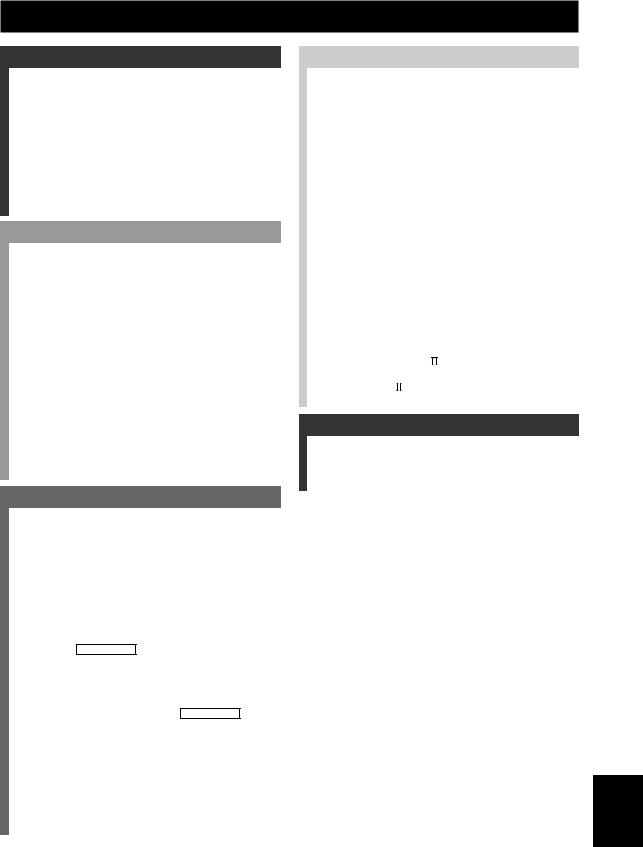
INTRODUCTION
CONTENTS
INTRODUCTION |
|
CONTENTS ............................................................ |
1 |
FEATURES ............................................................. |
2 |
GETTING STARTED ............................................ |
3 |
Checking the package contents ................................. |
3 |
Installing batteries in the remote control ................... |
3 |
CONTROLS AND FUNCTIONS ......................... |
4 |
Front panel ................................................................ |
4 |
Remote control .......................................................... |
6 |
Using the remote control ........................................... |
7 |
Front panel display .................................................... |
8 |
PREPARATION |
|
SPEAKER SETUP ................................................. |
9 |
Speakers .................................................................... |
9 |
Speaker placement .................................................... |
9 |
Connecting the speakers .......................................... |
10 |
CONNECTIONS .................................................. |
13 |
Before connecting components ............................... |
13 |
Connecting video components ................................ |
14 |
Connecting audio components ................................ |
16 |
Connecting the antennas ......................................... |
17 |
Connecting an external amplifier ............................ |
18 |
Connecting an external decoder .............................. |
18 |
Connecting the power supply cords ........................ |
19 |
Turning on the power .............................................. |
19 |
SPEAKER MODE SETTINGS .......................... |
20 |
ADJUSTING SPEAKER OUTPUT LEVELS .. |
21 |
Before you begin ..................................................... |
21 |
Using the test tone ................................................... |
21 |
BASIC OPERATION |
|
BASIC PLAYBACK ............................................ |
23 |
Input modes and indications .................................... |
25 |
Selecting a sound field program .............................. |
26 |
DIGITAL SOUND FIELD PROCESSING |
|
(DSP) ................................................................. |
29 |
Understanding sound fields ..................................... |
29 |
Hi-Fi DSP programs ................................................ |
29 |
CINEMA-DSP ...................................................... |
30 |
Sound design of CINEMA-DSP ............................. |
30 |
CINEMA-DSP programs ........................................ |
32 |
TUNING RX-V630RDS ......................................... |
34 |
Automatic and manual tuning ................................. |
34 |
Presetting stations .................................................... |
35 |
Tuning in to a preset station .................................... |
37 |
Exchanging preset stations ...................................... |
37 |
RECEIVING RDS STATIONS RX-V630RDS .... 38 |
|
Description of RDS data ......................................... |
38 |
Changing the RDS mode ......................................... |
38 |
PTY SEEK function ................................................ |
39 |
EON function .......................................................... |
39 |
SLEEP TIMER ..................................................... |
40 |
Setting the sleep timer ............................................. |
40 |
Canceling the sleep timer ........................................ |
40 |
RECORDING ....................................................... |
41 |
ADVANCED OPERATION |
|
|
SET MENU ........................................................... |
42 |
|
Adjusting the items on the SET MENU .................. |
42 |
|
1 |
SPEAKER SET (speaker mode settings) ............ |
43 |
2 |
LFE LEVEL ........................................................ |
45 |
3 |
SP DLY TIME (speaker delay time) ................... |
45 |
4 |
D. RANGE (dynamic range) ............................... |
46 |
5 |
L/R BALANCE (balance of the main left and |
|
|
right speakers) ..................................................... |
46 |
6 |
HP TONE CTRL (headphone tone control) ........ |
46 |
7 |
I/O ASSIGN (input/output assignment) .............. |
46 |
8 |
INPUT MODE (initial input mode) .................... |
47 |
9 |
DISPLAY SET .................................................... |
47 |
10MEM. GUARD (memory guard) ........................ |
47 |
|
REMOTE CONTROL FEATURES ................... |
48 |
|
Control area ............................................................. |
48 |
|
Setting the manufacturer code ................................. |
49 |
|
Clearing setup manufacturer codes ......................... |
49 |
|
Controlling other components ................................. |
50 |
|
ADJUSTING THE LEVEL OF THE EFFECT |
|
|
SPEAKERS ....................................................... |
51 |
|
ADJUSTING THE DELAY TIME ..................... |
52 |
|
ADJUSTING THE PARAMETER SETTINGS |
|
|
FOR PRO LOGIC MUSIC ......................... |
53 |
|
Changing parameter settings ................................... |
53 |
|
PRO LOGIC Music parameter descriptions ....... |
53 |
|
ADDITIONAL INFORMATION |
|
|
TROUBLESHOOTING ...................................... |
54 |
|
GLOSSARY .......................................................... |
58 |
|
SPECIFICATIONS .............................................. |
60 |
|
INTRODUCTION |
|
|
|
|
|
PREPARATION |
|
|
|
|
|
OPERATION |
BASIC |
|
|
|
|
OPERATION |
ADVANCED |
|
|
|
|
INFORMATION |
ADDITIONAL |
|
|
English
1
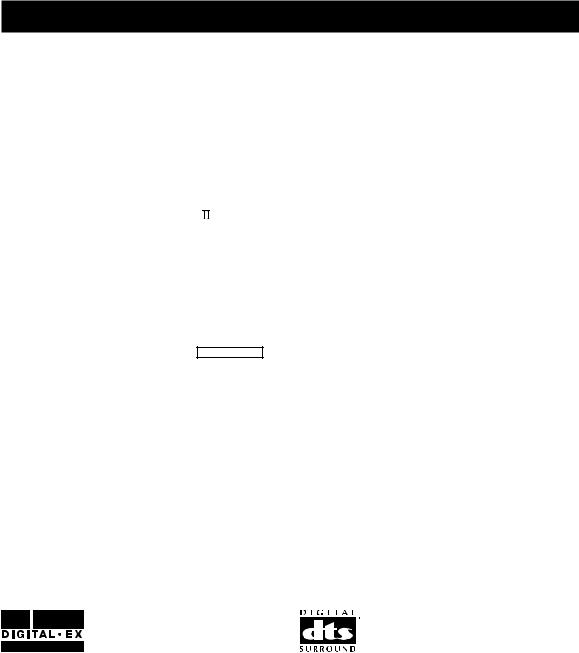
FEATURES
Built-in 6-channel power amplifier
Minimum RMS output power (0.06% THD, 20 Hz – 20 kHz, 8Ω)
Main: |
75 W + 75 W |
Center: |
75 W |
Rear: |
75 W + 75 W |
Rear center: |
75 W |
Multi-mode digital sound field processing
Dolby Pro Logic/Dolby Pro Logic decoder
Dolby Digital/Dolby Digital EX decoder
DTS/DTS-ES compatible decoder
CINEMA DSP: Combination of YAMAHA DSP technology and Dolby Pro Logic, Dolby Digital or DTS
Virtual CINEMA DSP
SILENT CINEMA DSP
Sophisticated AM/FM Tuner RX-V630RDS
40-Station random access preset tuning
Automatic preset tuning
Preset station shifting capability (Preset editing)
Other features
96-kHz/24-bit D/A converter
“SET MENU” for optimizing this unit for your Audio/Video system
Test tone generator for easier speaker balance adjustment
6-channel external decoder input
S-video signal input/output capability
Component video input/output capability
Optical and coaxial digital audio signal jacks
Sleep timer
Remote control with preset manufacturer codes
■ About this manual
•This document is the owner’s manual for both RX-V630RDS and DSP-AX630SE. Since DSP-AX630SE does not incorporate a tuner, descriptions on tuning are not applicable for DSP-AX630SE. Illustrations for the RX-V630RDS are mainly used for explanations.
•yindicates a tip for your operation.
•Some operations can be performed by using either the buttons on the main unit or on the remote control. In cases when the button names differ between the main unit and the remote control, the button name on the remote control is given in parentheses.
•This manual is printed prior to production. Design and specifications are subject to change in part for the reason of the improvement in operativity ability, and others. In this case, the product has priority.
Manufactured under license from Dolby Laboratories. |
“DTS”, “ES” and “DTS Digital Surround” are trademarks of |
|
Digital Theater Systems, Inc. |
“Dolby”, “Pro Logic”, and the double-D symbol are trademarks |
|
of Dolby Laboratories. |
|
2
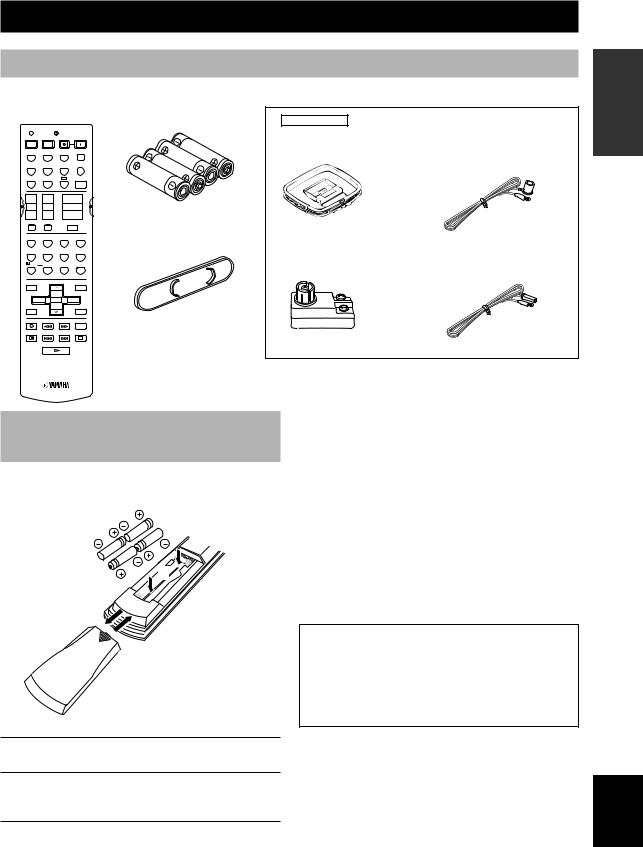
GETTING STARTED
Checking the package contents
Check your package to make sure it contains the following items.
Remote control |
Batteries (4) |
RX-V630RDS |
|
|||
|
|
|
|
(AAA, R03, UM-4) |
|
|
CODE SET |
TRANSMIT |
|
|
|
|
|
POWER |
POWER |
STANDBY |
SYSTEM |
|
|
|
POWER |
|
AM loop antenna |
Indoor FM antenna |
|||
TV |
AV |
|
|
|
||
CD |
MD/CD-R |
TUNER |
SLEEP |
|
|
(U.S.A., Canada, China, |
|
|
|
|
|
|
|
DVD |
D-TV/CBL V-AUX |
6CH INPUT |
|
|
Korea and General models) |
|
VCR 1 |
VCR2/DVR |
A |
AMP |
|
|
|
+ |
+ |
|
+ |
|
|
|
TV VOL |
TV CH |
VOLUME |
|
|
|
|
– |
– |
|
– |
|
|
|
TV MUTE |
TV INPUT |
|
|
|
|
|
|
|
MUTE |
|
|
|
|
HALL |
JAZZ CLUB |
ROCK |
ENTER- |
|
|
|
CONCERT |
TAINMENT |
|
|
|
||
1 |
2 |
3 |
4 |
Front VIDEO AUX jack cap |
|
|
TV |
MONO |
MOVIE |
MOVIE |
|
|
|
SPORTS |
MOVIE |
THEATER 1 THEATER 2 |
|
75-ohm/300-ohm antenna |
(Europe, U.K., Australia and |
|
/DTS |
6 |
7 |
8 |
|
||
5 |
|
|
|
|||
SUR. |
SELECT |
EX/ES |
STEREO |
|
adapter (U.K. model) |
Singapore models) |
9 |
0 |
+10 |
ENTER |
|
||
|
|
|
EFFECT |
|
|
|
LEVEL |
PRESET/CH |
SET MENU |
|
|
|
|
TITLE |
|
|
MENU |
|
|
|
|
|
|
A/B/C/D/E |
|
|
|
– |
SELECT |
+ |
|
|
|
|
TEST |
|
|
|
|
|
|
RETURN |
|
|
DISPLAY |
|
|
|
REC |
|
|
|
|
|
|
|
|
|
AUDIO |
|
|
|
DISC SKIP |
|
|
|
|
|
|
INTRODUCTION
Installing batteries in the remote
control
Insert the batteries in the correct direction by aligning the + and – marks on the batteries with the polarity markings (+ and –) inside the battery compartment.
2
1
3
1 Press the  part and slide off the battery compartment cover.
part and slide off the battery compartment cover.
2 Insert the four supplied batteries (AAA, R03,
UM-4) according to the polarity markings on the inside of the battery compartment.
3 Slide the cover back on so that it snaps into place.
■ Notes on batteries
•Change all of the batteries if you notice a decrease in the operating range of the remote control, that the indicator does not flash, or the light becoming dim.
•Do not use old batteries together with new ones.
•Do not use different types of batteries (such as alkaline and manganese batteries) together. Read the packaging carefully as these different types of batteries may have the same shape and color.
•If the batteries have leaked, dispose of them immediately. Avoid touching the leaked material or letting it come into contact with clothing, etc. Clean the battery compartment thoroughly before installing new batteries.
If the remote control is without batteries for more than 2 minutes, or if exhausted batteries remain in the remote control, the contents of the memory may be cleared. When the memory is cleared, insert new batteries, set up the manufacturer code that may have been cleared.
English
3
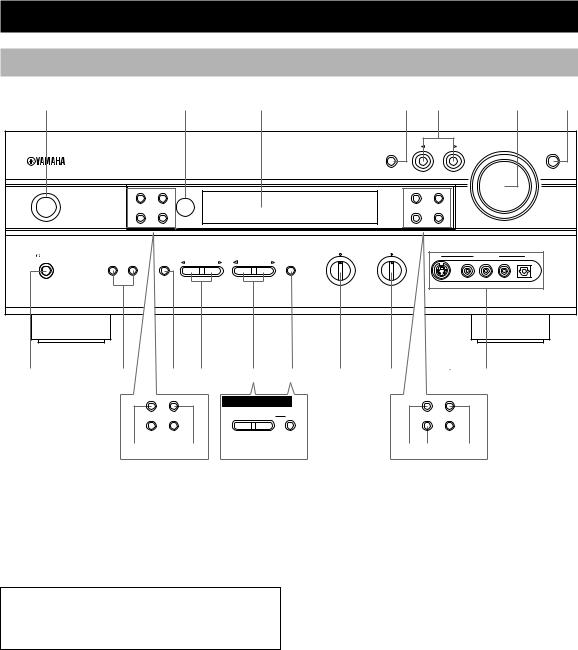
CONTROLS AND FUNCTIONS
Front panel
1 |
|
|
|
2 |
|
|
3 |
|
|
|
|
4 |
5 |
|
|
|
6 |
7 |
|
|
|
|
|
|
|
|
|
|
|
|
|
|
INPUT |
|
VOLUME |
|
|||
|
|
|
|
|
|
|
|
|
|
|
INPUT M0DE |
|
|
|
|
|
|
6CH INPUT |
|
|
NATURAL SOUND AV RECEIVER |
|
|
|
|
|
|
|
|
|
|
|
|
|
|
|
|
|
|
|
|
RDS MODE/FREQ |
EON |
|
|
|
|
|
|
|
|
PRESET/TUNING |
FM/AM |
|
|
|
|
|
|
STANDBY |
|
|
|
|
|
|
|
|
|
|
|
EDIT |
|
|
|
|
|
|
|
/ON |
|
PTY SEEK |
|
|
|
|
|
|
|
|
|
MEMORY |
|
|
|
|
|
||
|
|
MODE |
START |
|
|
|
|
|
|
|
|
TUNING MODE |
|
|
|
|
|
||
|
|
|
|
|
|
|
|
|
|
|
|
AUTO/MAN'L MONO |
MAN'L/AUTO FM |
|
|
|
|
|
|
|
|
|
|
|
|
|
|
|
|
BASS |
|
TREBLE |
|
|
|
|
|
|
|
SILENT |
SPEAKERS |
|
|
|
|
|
|
|
|
|
|
|
|
|
VIDEO AUX |
|
|
|
|
|
A |
B |
STEREO |
PROGRAM |
|
PRESET/TUNING |
|
A/B/C/D/E |
|
|
|
|
|
|
|
|
|
|
|
|
|
|
EFFECT |
|
|
|
|
|
|
|
|
|
|
|
|
|
|
|
|
PHONES |
|
|
|
|
|
|
|
|
– |
+ |
– |
+ |
S VIDEO |
VIDEO |
L AUDIO |
R |
OPTICAL |
|
|
|
|
|
|
|
|
|
|
|
|
|
|
|
|
|
|
|
|
(RX-V630RDS) |
|
8 |
|
9 |
0 |
q |
|
w |
|
e |
r |
|
t |
|
|
|
y |
|
|
|
|
|
|
RDS MODE/FREQ |
EON |
|
DSP-AX630SE |
|
|
PRESET/TUNING |
FM/AM |
|
|
|
|
|
|||||
|
|
|
|
|
|
|
|
|
|
|
|
|
|
|
|
||||
|
|
|
|
|
|
– |
|
+ |
|
|
|
EDIT |
|
|
|
|
|
|
|
|
|
PTY SEEK |
START |
|
SET MENU |
NEXT |
|
|
TUNING MODE |
MEMORY |
|
|
|
|
|
||||
|
|
MODE |
|
|
|
|
|
|
|
|
|
|
|
|
|
||||
|
|
|
|
|
AUTO/MAN'L |
MONO MAN'L/AUTO FM |
|
|
|
|
|
|
|
u i o p |
w e |
a s d f |
||||
1 STANDBY/ON
Turns this unit on, or set it to the standby mode. When you turn this unit on, you will hear a click and there will be a 4 to 5-second delay before this unit can reproduce sound.
Standby mode
In this mode, this unit will consume a small amount of power in order to receive infrared-signals from the remote control.
2 Remote control sensor
Receives signals from the remote control.
3 Front panel display
Shows information about the operational status of this unit.
4 INPUT MODE
5 INPUT l/ h
Selects the input source you want to listen to or watch.
6 VOLUME
Controls the output level of all audio channels. This does not affect the OUT (REC) level.
7 6CH INPUT
Selects the audio source connected to the 6CH INPUT jacks. This audio takes priority over the source selected with INPUT l/ h(or the input selector buttons on the remote control).
8  SILENT (PHONES jack)
SILENT (PHONES jack)
Allows you enjoy DSP effect for private listening with headphones. When you connect headphones, no signals are output to the speakers or the OUTPUT jacks.
9 SPEAKERS A/B
Sets the priority for the types of input signals (AUTO, DTS, ANALOG) to receive when one component is connected to two or more input jacks. Priority cannot be set when 6CH INPUT is selected as the input source.
Turns the set of main speakers connected to the A and/or B terminals on or off.
4
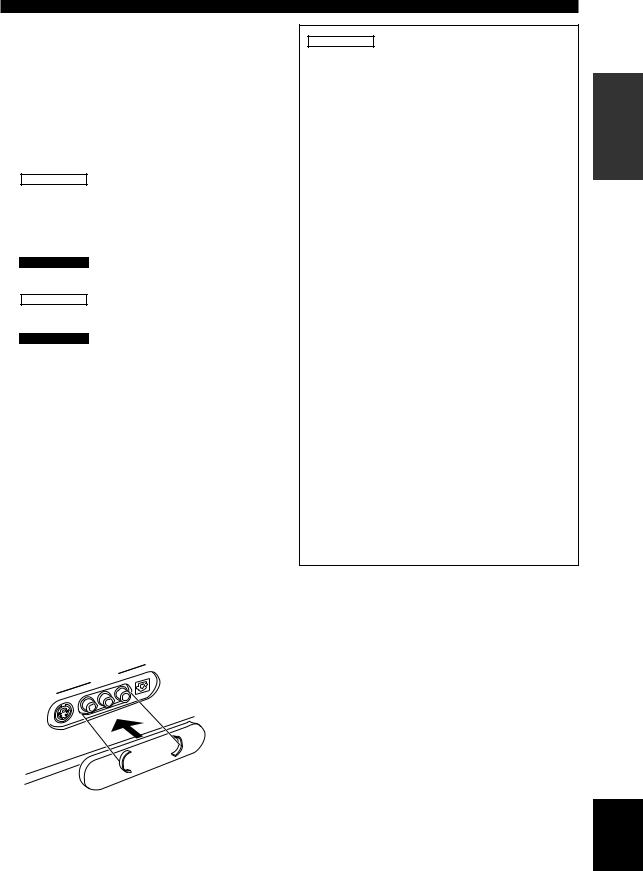
0 STEREO/EFFECT
Switches between normal stereo and DSP effect reproduction. When STEREO is selected, 2-channel signals are directed to the main left and right speakers without effect sounds and all Dolby Digital and DTS signals (except the LFE channel) are mixed down to the main left and right speakers.
q PROGRAM l / h
Selects the DSP program.
wRX-V630RDS PRESET/TUNING l / h
Selects preset station numbers 1 to 8 when the colon (:) appears in the front panel display.
Selects the tuning frequency when the colon (:) does not appear.
DSP-AX630SE SET MENU –/+
Adjusts the setting on the SET MENU.
eRX-V630RDS A/B/C/D/E
Selects preset station groups A to E.
DSP-AX630SE NEXT
Selects the SET MENU mode.
r BASS
Adjusts the low-frequency response for the main left and right channels.
Turn right to increase or turn left to decrease the lowfrequency response.
t TREBLE
Adjusts the high-frequency response for the main left and right channels.
Turn right to increase or turn left to decrease the highfrequency response.
y VIDEO AUX jacks
Inputs for audio and video signals from a portable external source (game console, etc.). Set the input source to V-AUX to enjoy source signals from these jacks. When the VIDEO AUX jacks on the front panel are not used, you can attach the provided front VIDEO AUX jack cap as shown in the illustration. When the cap is not attached, be sure retain it carefully.
|
AU |
X |
VID |
EO |
|
|
|
OPTICAL |
|
|
R |
|
|
DIO |
|
AU |
|
|
L |
|
EO
VID
EO
S VID
CONTROLS AND FUNCTIONS
RX-V630RDS
u RDS MODE/FREQ
When an RDS station is received, press this button to change the display mode among the PS mode, PTY mode, RT mode, CT mode (if the station offers those RDS data service) and/or frequency display mode in turn.
i PTY SEEK MODE
Press this button to set the unit in the PTY SEEK mode.
o PTY SEEK START
Press this button to begin searching for a station after the desired program type has been selected in the PTY SEEK mode.
p EON
Press this button to select the desired program type (NEWS, INFO, AFFAIRS, SPORT) when you want to tune in to a radio program of that type automatically.
a PRESET/TUNING (EDIT)
Switches the function of PRESET/TUNING l/ h between selecting a preset station number and tuning (the colon (:) turns on or off).
This button is also used to exchange the assignment of two preset stations with each other.
s TUNING MODE (AUTO/MAN’L MONO)
Switches the tuning mode between automatic and manual.
d MEMORY (MAN’L/AUTO FM)
Stores the current station in the memory.
f FM/AM
Switches the reception band between FM and AM.
INTRODUCTION
English
5
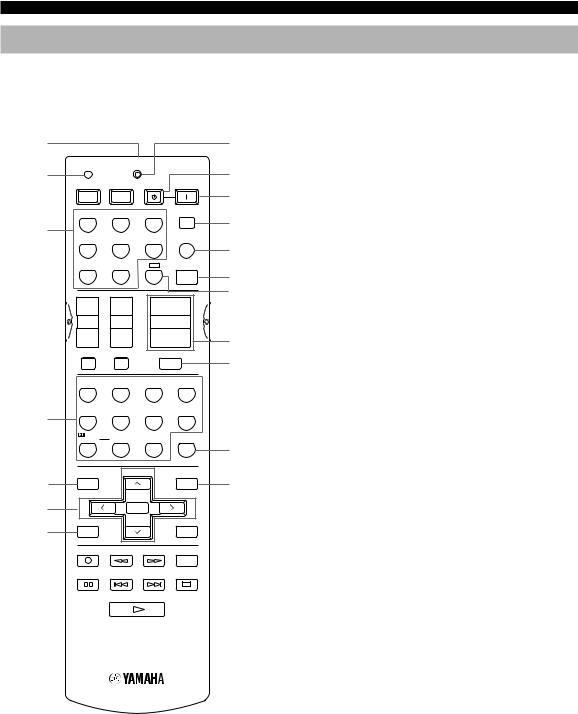
CONTROLS AND FUNCTIONS
Remote control
This section describes the remote control controls and their functions. Make sure that the AMP mode is selected before starting operation. See “REMOTE CONTROL FEATURES” on pages 48 to 50.
1 Infrared window
Outputs infrared control signals. Aim this window at the component you want to operate.
2 CODE SET
1 |
|
|
|
8 |
Used when setting up the manufacturer code (see page |
|
|
|
|
|
49). |
CODE SET |
TRANSMIT |
|
9 |
|
|
2 |
|
STANDBY |
SYSTEM |
3 Input selector buttons |
|
POWER |
POWER |
POWER |
|
Select the input source and set the remote control to |
|
TV |
AV |
|
|
0 |
|
CD |
MD/CD-R |
TUNER |
SLEEP |
|
operate the selected source component. |
3 |
|
|
|
q |
4 DSP program |
D-TV/CBL |
V-AUX |
|
|
||
DVD |
6CH INPUT |
|
Select DSP programs for the AMP position. Press a |
||
|
|
|
|
w |
|
|
|
|
|
button repeatedly to select a DSP program within that |
|
VCR 1 |
VCR2/DVR |
A |
AMP |
|
|
|
|
|
|
e |
group. |
|
|
|
|
r |
5 LEVEL |
+ |
+ |
|
+ |
|
|
|
|
Selects the effect speaker channel to be adjusted. |
|||
TV VOL |
TV CH |
VOLUME |
|
||
|
|
||||
– |
– |
|
– |
t |
6 Multi control section |
|
|
|
|
Used when changing the setting and to implement the |
|
TV MUTE |
TV INPUT |
|
|
y |
|
|
|
MUTE |
settings. |
||
HALL |
JAZZ CLUB |
ROCK |
ENTER- |
|
|
CONCERT |
TAINMENT |
|
7 TEST |
||
1 |
2 |
3 |
4 |
|
|
|
TV |
MONO |
MOVIE |
MOVIE |
4 |
SPORTS |
MOVIE |
THEATER 1 |
THEATER 2 |
5 |
6 |
7 |
8 |
|
|
/DTS |
|
EX/ES |
STEREO |
|
SUR. |
SELECT |
||
|
9 |
0 |
+10 |
ENTER |
|
|
|
|
EFFECT |
|
LEVEL |
PRESET/CH |
SET MENU |
|
5 |
TITLE |
|
|
MENU |
6 |
|
|
|
A/B/C/D/E |
– |
|
SELECT |
+ |
|
|
TEST |
|
|
|
7 |
RETURN |
|
|
DISPLAY |
|
REC |
|
|
|
|
|
|
|
AUDIO |
Outputs the test tone to adjust the speaker levels.
8 TRANSMIT indicator
Flashes while the remote control is sending signals.
u
9 STANDBY
i Sets this unit in the standby mode.
0 SYSTEM POWER
Turns on the power of this unit.
q SLEEP
Sets the sleep timer.
DISC SKIP
w 6CH INPUT
Selects the audio source connected to the 6CH INPUT jacks.
e AMP
Sets the remote control to the AMP mode for controlling this unit.
r Å
Sets the remote control to operate other component (not necessarily connected to this unit) without changing this unit’s input source.
t VOLUME +/–
Increases or decreases the volume level.
y MUTE
Mutes the sound. Press again to restore the audio output to the previous volume level.
6
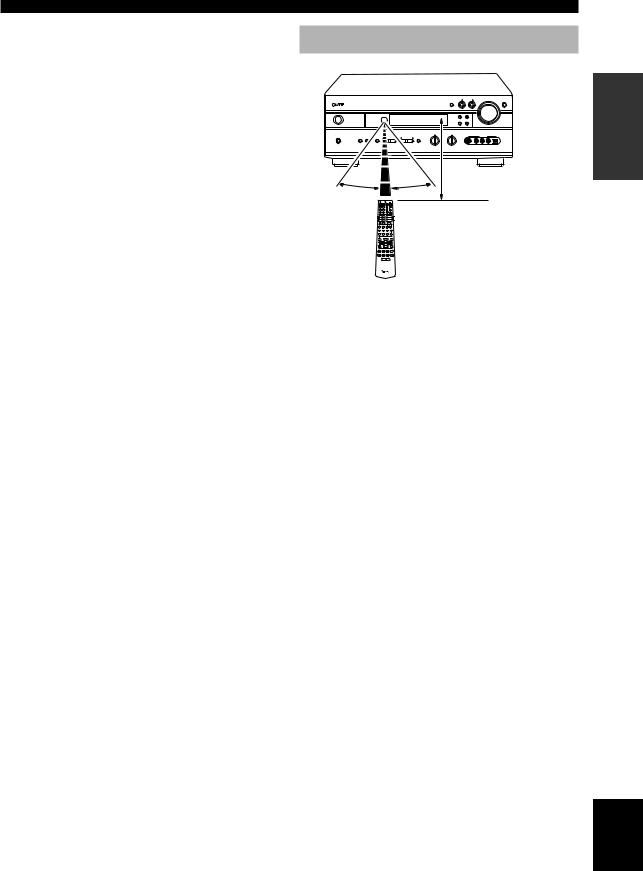
u STEREO/EFFECT
Switches between normal stereo and DSP effect reproduction. When STEREO is selected, 2-channel signals are directed to the main left and right speakers without effect sounds and all Dolby Digital and DTS signals (except the LFE channel) are mixed down to the main left and right speakers.
i SET MENU
Selects the SET MENU mode.
CONTROLS AND FUNCTIONS
Using the remote control
30° |
30° |
INTRODUCTION |
|
Approximately 6 m (20 feet) |
|||
|
|
The remote control transmits a directional infrared beam. Be sure to aim the remote control directly at the remote control sensor on the main unit during operation.
■ Handling the remote control
•Do not spill water or other liquids on the remote control.
•Do not drop the remote control.
•Do not leave or store the remote control in the following types of conditions:
–high humidity or temperature such as near a heater, stove or bath;
–dusty places; or
–in places subject to extremely low temperatures.
English
7
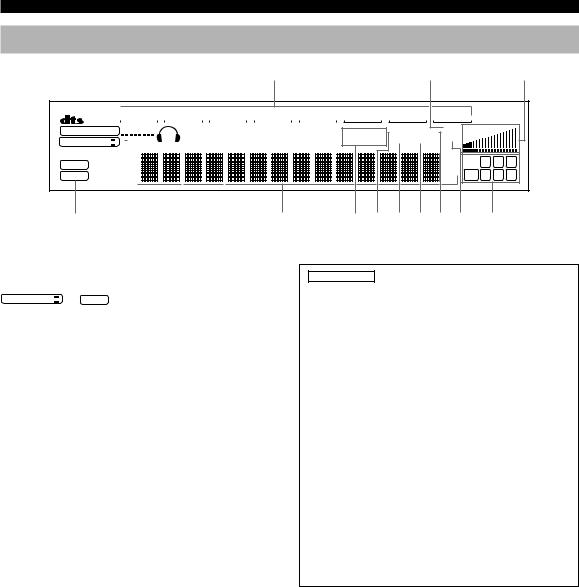
CONTROLS AND FUNCTIONS
Front panel display
1 |
2 |
3 |
4 |
|
|
|
|
|
|
|
|
|
|
|
|
|
|
|
|
|
|
|
|
|
|
|
|
|
|
|
MATRIX |
|
|
VCR2/DVR |
|
VCR1 |
|
V-AUX D-TV/CBL DVD |
|||||||||||||
|
|
|
|
|
|
||||||||||||||||||
|
|
|
DIGITAL |
|
|
|
|
|
|
|
|
|
|
|
|
|
|
|
|||||
|
|
|
VIRTUAL |
|
|
|
|
DTS |
|
DOLBY DIGITALPRO LOGIC |
|
|
|||||||||||
|
|
|
PRO LOGIC/ |
|
|
|
SILENT |
|
|
|
|
MOVIE THTR 12 ENTERTAINMENT |
|||||||||||
DSP |
|
|
|
|
|
|
|
|
|
|
|
|
|
|
|
|
|
|
|
||||
PCM |
|
|
|
|
|
|
|
|
|
|
|
|
|
|
|
|
|
|
|
||||
|
|
|
|
|
|
|
|
|
|
|
|
|
|
|
|
|
|
|
|||||
|
|
|
|
|
|
|
|
|
|
|
|
|
|
|
|
|
|
|
|
|
|
|
|
MD/CD-R |
TUNER |
CD |
|
|
|
|
PS PTY RT CT |
STEREO AUTO |
MUTE VOLUME |
|
|||
EON PTY HOLD TUNED MEMORY |
SLEEP |
|
|
|
|
|
|
|
dB |
|
L |
C |
R |
|
|
LFE |
RL |
RC |
RR |
|
|
|
mS |
||||
|
|
|
|
|
|
|
5 |
6 |
7 |
8 |
9 |
||||||||
1 Processor indicators |
|
|
|
|||||||||
Lights up when the t, g, VIRTUAL, |
|
|||||||||||
|
|
|
|
PRO LOGIC/ |
|
|
|
or |
DSP are activated. |
|
|
|
|
|
|
|
|
|
|
|
|||||
MATRIX lights up when the Dolby Digital EX decoder or the DTS-ES compatible decoder is activated.
2 Input source indicator
Shows the current input source with a cursor.
3 MUTE indicator
Flashes while the MUTE function is on.
4 VOLUME level indicator
Indicates the volume level.
5 vindicator
Lights up when this unit is reproducing PCM (pulse code modulation) digital audio signals.
6 SILENT indicator
Lights up when headphones are connected while the digital sound field processor is on.
7 Headphones indicator
Lights up when headphones are connected.
8 DSP program indicators
The name of the selected DSP program lights up when the ENTERTAINMENT, MOVIE THEATER 1, MOVIE THEATER 2 or V/DTS SURROUND DSP program is selected.
9 Multi-information display
Shows the current DSP program name and other information when adjusting or changing settings.
0 q w e r t y
(RX-V630RDS)
RX-V630RDS
0 RDS indicator
The name(s) of the RDS data offered by the currently received RDS station light(s) up.
EON indicator lights up when an RDS station that offers the EON data service is being received. PTY HOLD indicator lights up while searching for stations in the PTY SEEK mode.
q STEREO indicator
Lights up when this unit is receiving a strong signal for an FM stereo broadcast while the “AUTO” indicator is lit.
w TUNED indicator
Lights up when this unit is tuned to a station.
e MEMORY indicator
Flashes to show a station can be stored.
r AUTO indicator
Shows that this unit is in the automatic tuning mode.
t SLEEP indicator
Lights up while the sleep timer is on.
y Input channel indicator
Indicates the channel components of input signals being received.
8
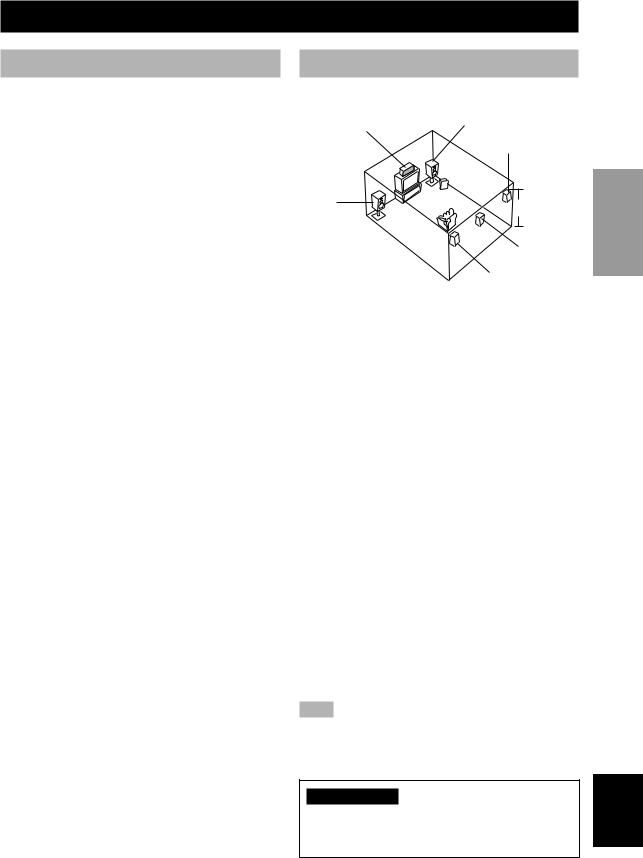
PREPARATION
SPEAKER SETUP
Speakers
This unit has been designed to provide the best soundfield quality with a 6-speaker system, using main left and right speakers, rear left and right speakers, a center speaker, and a rear center speaker. If you use different brands of speakers (with different tonal qualities) in your system, the tone of a moving human voice and other types of sound may not shift smoothly. We recommend that you use speakers from the same manufacturer or speakers with the same tonal quality.
The main speakers are used for the main source sound plus effect sounds. They will probably be the speakers from your present stereo system. The rear speakers are used for effect and surround sounds. The center speaker is for the center sounds (dialog, vocals, etc.). The rear center speaker supplements the rear (left and right) speakers and provides for more realistic front-to-back transitions.
The main speakers should be high-performance models and have enough power-handling capacity to accept the maximum output of your audio system. The other speakers do not have to be equal to the main speakers. For precise sound localization, however, it is ideal to use the models of equivalent performance with the main speakers.
■Use of a subwoofer expands your sound field
It is also possible to further expand your system with the addition of a subwoofer. The use of a subwoofer is effective not only for reinforcing bass frequencies from any or all channels, but also for reproducing the LFE (low-frequency effect) channel with high fidelity when playing back Dolby Digital or DTS signals. The YAMAHA Active Servo Processing Subwoofer System is ideal for natural and lively bass reproduction.
Speaker placement
Refer to the following diagram when you place the speakers.
Center speaker |
Main speaker (R) |
|
Rear speaker (R) |
|
Subwoofer |
Main |
1.8 m (6 feet) |
speaker (L) |
|
|
Rear center |
|
speaker |
|
Rear speaker (L) |
■ Main speakers
Place the main left and right speakers an equal distance from the ideal listening position. The distance between each speaker and each side of the video monitor should also be the same.
■ Center speaker
Align the front face of the center speaker with the front face of your video monitor. Place the speaker as close to the monitor as possible (such as directly over or under the monitor) and centrally between the main speakers.
■ Rear speakers
Place these speakers behind your listening position, facing slightly inwards, nearly 1.8 m (6 feet) above the floor.
■ Rear center speaker
Place the rear center speaker in the center between the rear left and right speakers at the same height from the floor as the rear speakers.
■ Subwoofer
The position of the subwoofer is not so critical, because low bass sounds are not highly directional. But it is better to place the subwoofer near the main speakers. Turn it slightly toward the center of the room to reduce wall reflections.
Note
•If you do not use any of effect speakers (rear, center and/or rear center), change the settings of SPEAKER SET items at the SET MENU to designate the signals to other terminals you connect speakers to.
CAUTION
Use magnetically shielded speakers. If this type of speakers still creates the interference with the monitor, place the speakers away from the monitor.
PREPARATION
English
9
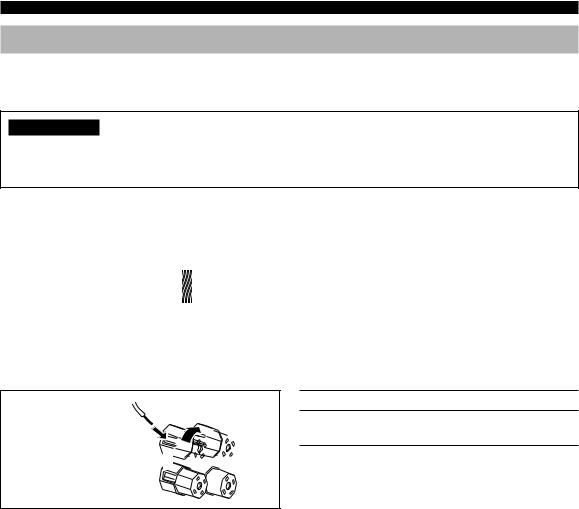
SPEAKER SETUP
Connecting the speakers
Be sure to connect the left channel (L), right channel (R), “+” (red) and “–” (black) properly. If the connections are faulty, no sound will be heard from the speakers, and if the polarity of the speaker connections is incorrect, the sound will be unnatural and lack bass.
CAUTION
•Use speakers with the specified impedance shown on the rear panel of this unit.
•Do not let the bare speaker wires touch each other or any metal part of this unit. This could damage this unit and/or the speakers.
If necessary, use the SET MENU to change the speaker mode settings according to the number and size of the speakers in your configuration after you finish connecting your speakers.
■ Speaker cables
|
|
|
|
|
|
|
|
|
A speaker cord is actually a pair of insulated cables |
|
|
|
|
|
|
|
|
||
|
|
|
|
|
|
|
|
|
running side by side. One cable is colored or shaped |
|
|
|
|
|
|
|
|||
10 mm (3/8”) |
|
|
|
|
|
|
|
differently, perhaps with a stripe, groove or ridge. |
|
|
|
|
|
|
|
|
|
|
|
|
|
|
|
|
|
|
|
|
1 Remove approximately 10 mm (3/8”) of |
|
|
|
|
|
|
|
|||
1 |
|
|
2 |
|
|
|
insulation from each of the speaker cables. |
||
|
|
|
|
|
|
||||
|
|
|
|
|
2 Twist the exposed wires of the cable |
||||
|
|
|
|
|
|
|
|
|
|
|
|
|
|
|
|
|
|
|
together to prevent short circuits. |
|
|
|
|
|
|
|
|
||
■ Connecting to the SPEAKERS terminals
Red: positive (+) |
2 |
3 |
|
Black: negative (–) |
|||
|
1
1 Unscrew the knob.
2 Insert one bare wire into the hole in the side of each terminal.
3 Tighten the knob to secure the wire.
■ MAIN SPEAKERS terminals
One or two speaker systems can be connected to these terminals. When using only one speaker system, it can be connected to either the MAIN A or the MAIN B terminals.
■ REAR SPEAKERS terminals
A rear speaker system can be connected to these terminals.
■ CENTER SPEAKER terminals
A center speaker can be connected to these terminals.
■ REAR CENTER SPEAKER terminals
A rear center speaker can be connected to these terminals.
10
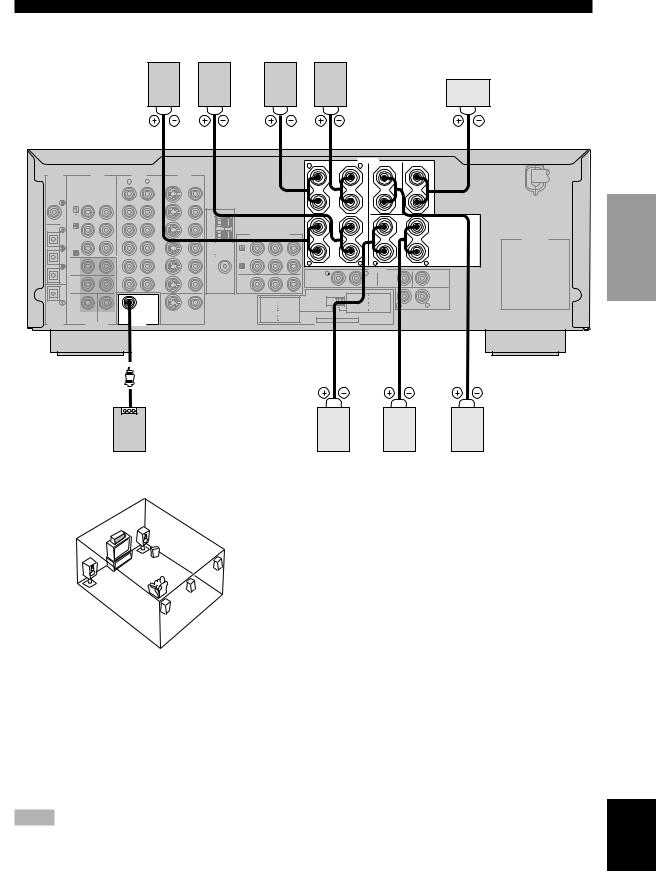
SPEAKER SETUP
Main B speaker |
Main A speaker |
|
||
Right |
Left |
Right |
Left |
Center |
|
|
|
|
|
|
|
|
|
speaker |
|
1 |
|
|
2 |
|
|
|
|
3 |
|
|
|
|
|
|
|
|
|
|
|
|
|
MAIN |
SPEAKERS |
|
CENTER |
|
|
|
|
|
|
|
|
|
|
|
|
|
|
R |
L |
REAR CENTER |
|
|||
|
|
|
|
|
|
|
|
|
|
|
|
|
|
|
|
|
||
DIGITAL |
AUDIO |
|
AUDIO |
VIDEO |
|
|
|
|
|
|
|
|
+ |
|
+ |
|
+ |
|
INPUT |
|
|
R |
L |
S VIDEO |
VIDEO |
|
|
|
|
|
|
|
|
|
|||
|
|
|
|
|
|
|
|
|
|
|
|
|
|
|
||||
|
|
|
|
|
OUT |
|
|
|
|
|
|
|
|
A |
|
|
|
|
|
|
|
|
|
|
|
|
|
|
|
|
|
|
|
|
|
|
|
CD |
|
|
|
|
VCR 2 |
|
|
|
|
|
|
|
|
– |
|
– |
|
– |
|
|
|
|
|
/VDR |
|
|
|
|
|
|
|
|
|
|
|
|
|
|
CD |
|
|
|
IN |
|
TUNER |
|
|
|
|
|
|
|
|
|
|
|
|
|
|
|
|
|
|
|
|
|
|
|
|
|
|
|
|
|
|
COAXIAL |
|
|
|
|
|
|
AM |
|
|
|
|
|
|
|
|
|
|
|
OPTICAL |
|
|
|
|
|
|
ANT |
|
|
|
|
|
|
– |
|
|
|
– |
D-TV/CBL |
OUT |
|
|
|
OUT |
|
|
|
|
|
|
|
|
|
|
|
|
|
|
(REC) |
|
|
|
|
|
GND |
|
COMPONENT VIDEO |
|
|
B |
|
|
|
|
||
|
MD |
|
|
|
VCR 1 |
|
|
|
PR/CR |
PB/CB |
Y |
|
|
|
|
AC OUTLETS |
||
|
/CD-R |
|
|
|
|
|
|
|
|
|
|
|||||||
|
IN |
|
|
|
|
|
|
|
DVD |
|
|
|
|
|
|
|
|
|
DVD |
(PLAY) |
|
|
|
IN |
|
|
|
|
|
|
|
|
+ |
|
|
|
+ |
|
|
|
|
|
|
|
|
|
|
|
|
|
|
|
|
|
||
|
|
|
|
|
|
|
75 |
UNBAL. |
D-TV |
|
|
|
|
|
|
|
|
|
|
|
|
|
|
|
|
|
|
/CBL |
|
|
R |
|
L |
R |
REAR |
L |
|
MD/CD-R |
MAIN |
|
|
|
D-TV |
|
FM |
|
|
|
|
|
(SURROUND) |
|||||
|
|
|
/CBL |
|
ANT |
|
|
|
|
|
|
|
OUTPUT |
|
|
|
||
|
|
|
|
|
|
|
|
|
|
|
|
L |
|
|
|
|||
|
|
|
|
|
|
|
|
|
MONITOR |
|
|
|
R |
REAR |
|
|
|
|
|
|
|
|
|
|
|
|
|
|
|
|
MAIN |
|
|
|
CENTER |
||
|
|
|
|
|
|
|
|
|
OUT |
|
|
|
|
|
CENTER |
|
|
|
|
SURROUND |
|
|
|
DVD |
|
|
|
|
|
|
|
|
|
|
|
|
|
|
|
|
|
|
|
|
|
|
|
|
|
|
MAIN A OR B: 8 |
MIN. /SPEAKER |
|
|
|
|
|
|
|
|
SUB |
|
|
|
|
|
MAIN |
|
|
|
A+B:16 |
MIN. /SPEAKER |
|
|
|
MD/CD-R |
|
|
|
|
|
|
|
|
A OR B:4 MIN. /SPEAKER |
CENTER |
: 8 |
MIN. /SPEAKER |
R |
REAR |
L |
|||
OPTICAL |
|
|
|
WOOFER |
|
|
|
|
A+B :8 |
MIN. /SPEAKER |
REAR CENTER: 8 |
MIN. /SPEAKER |
(SURROUND) |
|||||
|
SUB |
|
|
|
|
|
|
|
|
CENTER :6 |
MIN. /SPEAKER |
REAR |
: 8 |
MIN. /SPEAKER |
|
|
|
|
|
CENTER |
|
|
S VIDEO |
VIDEO |
|
|
|
REAR CENTER |
MIN. /SPEAKER |
|
|
|
|
|
|
||
|
WOOFER |
|
|
|
|
|
|
|
:6 |
|
|
|
|
|
|
|||
DIGITAL |
6CH INPUT |
OUTPUT |
MONITOR OUT |
|
|
|
REAR :6 |
MIN. /SPEAKER |
SET BEFORE POWER ON |
|
|
|
|
|
||||
OUTPUT |
|
|
|
|
|
|
|
|
IMPEDANCE SELECTOR |
|
|
|
|
|||||
(RX-V630RDS) |
|
|
|
|
|
|
|
|
|
|
|
|
|
|
|
|
|
|
|
|
4 |
|
|
|
|
|
|
|
|
|
5 |
|
|
6 |
|
|
7 |
Subwoofer |
Right |
Left |
Rear center |
|
system |
||||
Rear speaker |
speaker |
|||
|
||||
|
|
|||
31
4
2
5
7
6
PREPARATION
The diagram shows the speaker layout in the listening room.
■ SUBWOOFER jack
When using a subwoofer with built-in amplifier, including the YAMAHA Active Servo Processing Subwoofer System, connect the input jack of the subwoofer system to this jack. Low bass signals distributed from the main, center and/or rear channels are directed to this jack in accordance with your SPEAKER SET selections. The LFE (low-frequency effect) signals generated when Dolby Digital or DTS is decoded are also directed to this jack in accordance with your SPEAKER SET selections.
Notes
•The cut-off frequency of the SUBWOOFER jack is 90 Hz.
•If you do not use a subwoofer, designate the signals to the main left and right speakers by changing the setting of SPEAKER SET item “1E BASS” on the SET MENU to MAIN.
•Use the control on the subwoofer to adjust its volume level. It is also possible to adjust the volume level by using this unit’s remote control (see “ADJUSTING THE LEVEL OF THE EFFECT SPEAKERS” on page 51).
English
11
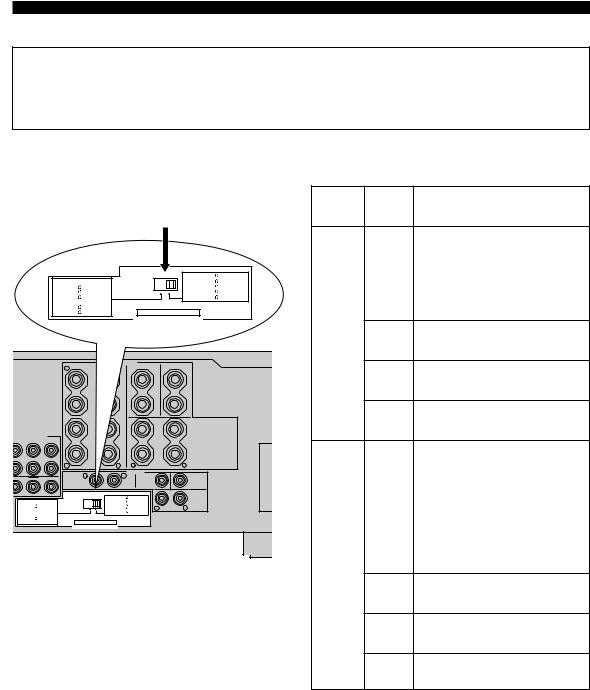
SPEAKER SETUP
■ IMPEDANCE SELECTOR switch
WARNING
Do not change setting of the IMPEDANCE SELECTOR switch when the power of this unit is on, this may damage the unit. If this unit fails to turn on when STANDBY/ON (or SYSTEM POWER) is pressed, the IMPEDANCE SELECTOR switch may not be fully slid to either position. If so, slide the switch all the way to either position when this unit is in the standby mode.
Select the switch position (left or right) according to the impedance of the speakers in your system. Be sure to move this switch only when this unit is in the standby mode.
|
|
|
|
|
|
IMPEDANCE |
Switch |
Speaker |
Impedance level |
|
|
|
|
|
|
|
SELECTOR |
|
|||
|
|
|
|
|
|
|
position |
|
|
|
|
|
|
|
|
|
switch |
|
|
|
|
|
|
|
|
|
|
|
|
|
|
If you use one set of main speakers, |
|
|
|
|
|
|
|
|
|
|
the impedance of each speaker must |
|
|
|
|
|
|
|
|
|
Main |
be 4 Ω or higher. |
|
|
|
|
|
|
MAIN A OR B: 8 |
MIN. /SPEAKER |
|
If you use two sets of main speakers, |
|
|
MAIN |
|
|
|
|
A+B:16 |
MIN. /SPEAKER |
|
||
|
A OR B:4 MIN. /SPEAKER |
|
|
CENTER |
: 8 |
MIN. /SPEAKER |
|
the impedance of each speaker must |
||
|
A+B :8 |
MIN. /SPEAKER |
|
|
REAR CENTER: 8 |
MIN. /SPEAKER |
|
|||
|
CENTER :6 |
MIN. /SPEAKER |
|
|
REAR |
: 8 |
MIN. /SPEAKER |
|
be 8 Ω or higher. |
|
|
REAR CENTER |
MIN. /SPEAKER |
|
|
|
|
|
|
||
|
|
:6 |
|
|
|
|
|
|
||
|
REAR |
:6 |
MIN. /SPEAKER |
|
SET BEFORE POWER ON |
|
|
|
|
|
|
|
|
|
|
IMPEDANCE SELECTOR |
|
|
|
|
|
|
|
|
|
|
|
|
|
Left |
Center |
The impedance must be 6 Ω or |
|
|
|
|
|
|
|
|
|
|
higher. |
|
|
|
|
|
|
|
|
|
Rear |
The impedance must be 6 Ω or |
|
|
|
|
|
|
|
|
|
Center |
higher. |
|
|
|
|
|
|
|
|
|
Rear |
The impedance of each speaker must |
|
|
|
|
|
|
|
|
|
|
be 6 Ω or higher. |
|
|
|
|
|
|
|
|
|
|
If you use one set of main speakers, |
|
|
|
|
|
|
|
|
|
|
the impedance of each speaker must |
|
|
|
|
|
|
|
|
|
|
be 8 Ω or higher. |
|
|
|
MAIN A OR B: 8 |
MIN. /SPEAKER |
|
|
|
|
If you use two sets of main speakers, |
|
|
|
|
|
|
|
|
|
|||
MAIN |
MIN. /SPEAKER |
|
|
A+B:16 |
MIN. /SPEAKER |
R (SURROUND) L |
|
|
Main |
the impedance of each speaker must |
A+B :8 |
|
REAR CENTER: 8 |
MIN. /SPEAKER |
|
|
|||||
A OR B:4 |
MIN. /SPEAKER |
|
CENTER |
: 8 |
MIN. /SPEAKER |
REAR |
|
|
|
|
CENTER :6 |
MIN. /SPEAKER |
|
REAR |
: 8 |
MIN. /SPEAKER |
|
|
|
|
be 16 Ω or higher. |
REAR CENTER |
MIN. /SPEAKER |
SET BEFORE POWER ON |
|
|
|
|
|
|
||
REAR :6 |
|
|
|
|
|
|
||||
:6 |
MIN. /SPEAKER |
|
|
|
|
|
|
|
|
|
|
|
IMPEDANCE SELECTOR |
|
|
|
|
|
[Canada model only] |
||
|
|
|
|
|
|
|
|
|
|
|
(RX-V630RDS) |
|
|
|
|
|
|
|
The impedance of each speaker must |
||
|
|
|
|
|
|
|
|
Right |
|
be 8 Ω or higher. |
|
|
|
|
|
|
|
|
|
Center |
The impedance must be 8 Ω or |
|
|
|
|
|
|
|
|
|
|
higher. |
|
|
|
|
|
|
|
|
|
Rear |
The impedance must be 8 Ω or |
|
|
|
|
|
|
|
|
|
Center |
higher. |
|
|
|
|
|
|
|
|
|
Rear |
The impedance of each speaker must |
|
|
|
|
|
|
|
|
|
|
be 8 Ω or higher. |
12
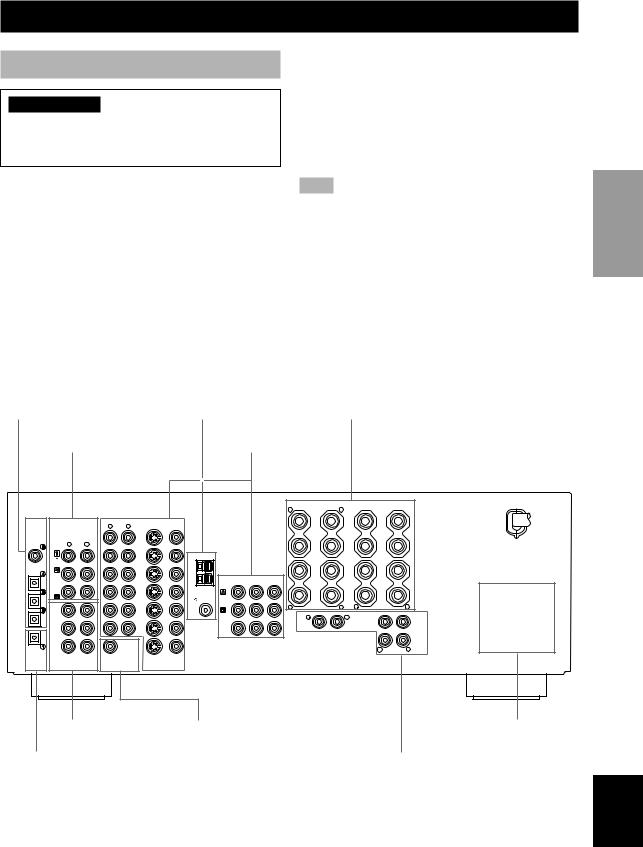
CONNECTIONS
Before connecting components
CAUTION
Do not connect this unit or other components to the mains power until all connections between the components have been completed.
•Be sure all connections are made correctly, that is to say L (left) to L, R (right) to R, “+” to “+” and “–” to “–”. Some components require different connection methods and have different jack names. Refer to the operation instructions for each component to be connected to this unit.
•When you connect other YAMAHA audio components (such as a tape deck, MD recorder and CD player or changer), connect them to the jack with the same number labels as !, #, $ etc. YAMAHA applies this labeling system to all its products.
•After you have completed all connections, check them again to make sure they are correct.
•The name of jack corresponds to input selector.
■ Connecting to digital jacks
This unit has digital jacks for direct transmission of digital signals through either coaxial or fiber optic cables. You can use the digital jacks to input PCM, Dolby Digital and DTS bitstreams. To enjoy multi-channel sound track of DVD software, etc. with DSP effect, you need to make digital connection. All digital input jacks are acceptable for 96-kHz sampling digital signals.
Note
•The OPTICAL jacks on this unit conform to the EIA standard. If you use a fiber optic cable that does not conform to this standard, this unit may not function properly.
PREPARATION
DIGITAL INPUT jacks |
Antenna input terminals |
Speaker terminals |
(pages 13-16) |
(page 17) |
(pages 10-11) |
Audio component jacks |
Video component jacks |
|
(page 16) |
(pages 14-15) |
|
(RX-V630RDS)
|
|
|
|
|
|
|
|
|
|
MAIN |
SPEAKERS |
|
|
CENTER |
|
|
|
|
|
|
|
|
|
|
|
R |
L |
REAR CENTER |
|
|
|||
|
|
|
|
|
|
|
|
|
|
|
|
|
|
|
||
DIGITAL |
AUDIO |
|
|
AUDIO |
VIDEO |
|
|
|
|
|
+ |
|
+ |
|
|
+ |
INPUT |
|
|
R |
L |
S VIDEO |
VIDEO |
|
|
|
|
|
|
|
|
|
|
|
|
|
|
OUT |
|
|
|
|
|
|
A |
|
|
|
|
|
|
|
|
|
|
|
|
|
|
|
|
|
|
|
|
|
|
CD |
R |
L |
|
VCR 2 |
|
|
|
|
|
|
– |
|
– |
|
|
– |
|
|
|
|
/VDR |
|
|
|
|
|
|
|
|
|
|
|
|
|
CD |
|
|
IN |
|
TUNER |
|
|
|
|
|
|
|
|
|
|
|
|
|
|
|
|
|
|
|
|
|
|
|
|
|
|
|
COAXIAL |
|
|
|
|
|
AM |
|
|
|
|
|
|
|
|
|
|
OPTICAL |
|
|
|
|
|
ANT |
|
|
|
|
– |
|
|
|
|
– |
D-TV/CBL |
OUT |
|
|
OUT |
|
|
|
|
|
|
|
|
|
|
|
|
|
(REC) |
|
|
|
|
GND |
COMPONENT VIDEO |
|
|
B |
|
|
|
|
|
|
|
MD |
|
|
VCR 1 |
|
|
PR/CR |
PB/CB |
Y |
|
|
|
|
|
|
|
|
/CD-R |
|
|
|
|
|
|
|
|
|
|
|||||
|
IN |
|
|
|
|
|
DVD |
|
|
|
|
|
|
|
|
|
DVD |
(PLAY) |
|
|
IN |
|
|
|
|
|
|
+ |
|
|
|
|
+ |
|
|
|
|
|
|
|
|
|
|
|
|
|
|
|
||
|
|
|
|
|
|
75 UNBAL. |
D-TV |
|
|
|
|
|
|
|
|
|
|
|
|
|
|
|
|
/CBL |
|
R |
|
L |
R |
REAR |
|
L |
|
MD/CD-R |
MAIN |
|
|
D-TV |
|
FM |
|
|
|
(SURROUND) |
|
|||||
|
|
/CBL |
|
ANT |
|
|
|
|
|
OUTPUT |
|
|
|
|||
|
|
|
|
|
|
|
|
|
L |
|
|
|
||||
|
|
|
|
|
|
|
MONITOR |
|
|
R |
|
REAR |
|
|
|
|
|
|
|
|
|
|
|
|
|
MAIN |
|
|
|
|
CENTER |
||
|
|
|
|
|
|
|
OUT |
|
|
|
|
|
CENTER |
|
|
|
|
SURROUND |
|
|
DVD |
|
|
|
|
|
|
|
|
|
|
|
|
MD/CD-R |
|
|
|
SUB |
|
|
|
|
|
|
|
|
|
REAR |
|
|
|
|
|
WOOFER |
|
|
|
|
|
|
|
|
R |
L |
|||
OPTICAL |
|
|
|
|
|
|
|
|
|
|
|
(SURROUND) |
||||
|
SUB |
|
|
S VIDEO |
VIDEO |
|
|
|
|
|
|
|
|
|
|
|
|
WOOFER CENTER |
|
|
|
|
|
|
|
|
|
|
|
||||
|
|
|
|
|
|
|
|
|
|
|
|
|
|
|
||
DIGITAL |
6CH INPUT |
OUTPUT |
MONITOR OUT |
|
|
|
|
|
|
|
|
|
|
|||
OUTPUT |
|
|
|
|
|
|
|
|
|
|
|
|
||||
6CH INPUT jacks |
SUBWOOFER OUTPUT |
AC OUTLETS |
(page 18) |
jack (page 11) |
(page 19) |
DIGITAL OUTPUT jack |
|
OUTPUT jacks |
(page 16) |
|
(page 18) |
English
13

CONNECTIONS
Connecting video components
Refer to the connection examples on the next page.
■ Types of video jacks
There are three types of video jacks as follows:
S VIDEO |
VIDEO |
COMPONENT VIDEO |
|
||||
PR/CR PB/CB |
Y |
||||||
|
|
|
|
||||
|
|
|
|
|
|
|
|
|
|
|
|
|
|
|
|
|
|
|
|
|
|
|
|
2 1 3
1VIDEO jack
Conventional composite video signal.
2 S VIDEO jack
Transmits color and luminance separately and achives high-quality color reproduction.
3 COMPONENT VIDEO jacks
Transmit color difference (PB/CB, PR/CR) and luminance separately and provide the best quality picture.
•Each type of video jack works independently. Signals input through the composite video, S-video and component jacks are only output through the corresponding composite video, S-video, and component jacks.
•Use a commercially available cable specified for connecting each type of jacks.
•The description of the component video jacks may differ depending on the component (e.g. Y, CB, CR/Y, PB, PR/Y, B-Y, R-Y etc.). When using these jacks, refer also to the operation instructions for the component being connected.
■ Connecting a video monitor
Connect the video input jack on your video monitor to the MONITOR OUT VIDEO jack.
Note
•If you connect this unit with a source component using S-video (or Component video) jacks, you also need to connect your video monitor using S-video (or Component video) jacks.
■Connecting a DVD player/digital TV/cable TV
Connect the optical digital audio signal output jack on your component to the DIGITAL INPUT jack and connect the video signal output jack on the component to the VIDEO jack on this unit.
Then connect AUDIO jacks on your component to the AUDIO jacks on this unit.
y
•If your video component has an S-video output or component video output, connect the S-video signal output jack on the component to the S VIDEO jack or connect the component video signal output jacks on the component to the COMPONENT VIDEO jacks.
•The AUDIO jacks are available for a video component which does not have optical digital output jack. However, multichannel reproduction cannot be obtained with audio signals input from AUDIO jacks.
■Connecting a game console or camcorder
Connect the optical digital audio signal output jack on your video component to the OPTICAL jack on the front panel and connect video signal output jack on the component to the VIDEO jack on the front panel.
y
•If your video component has an S-video output, connect the S- video signal output jack on the component to the S VIDEO jack.
•The AUDIO jacks are available for a video component such as a camcorder which does not have optical digital output jack.
■ Connecting a VCR or DVR (digital video recorder)
Connect the audio signal input jacks on your video component to the AUDIO OUT jacks and connect the video signal input jack on the video component to the VIDEO OUT jack on this unit for picture recording. Connect the audio signal output jacks on your component to the AUDIO IN jacks and connect the video signal output jack on the component to the VIDEO IN jack on this unit to play a source from your recording component. Second VCR or digital video recorder can be connected using VCR 2/DVR jacks.
y
•If your video component has an S-video input, connect the S- video signal input jack on the component to the S VIDEO OUT jack.
•If your video component has an S-video output, connect the S- video signal output jack on the component to the S VIDEO IN jack.
Notes
•Once you have connected a recording component to this unit, keep its power turned on while using this unit. If the power is off, this unit may distort the sound from other components.
•S-video and component video signals pass independently through this unit’s video circuit. Make sure to connect this unit to both a source component and a recording component using the video jacks of the same system.
14
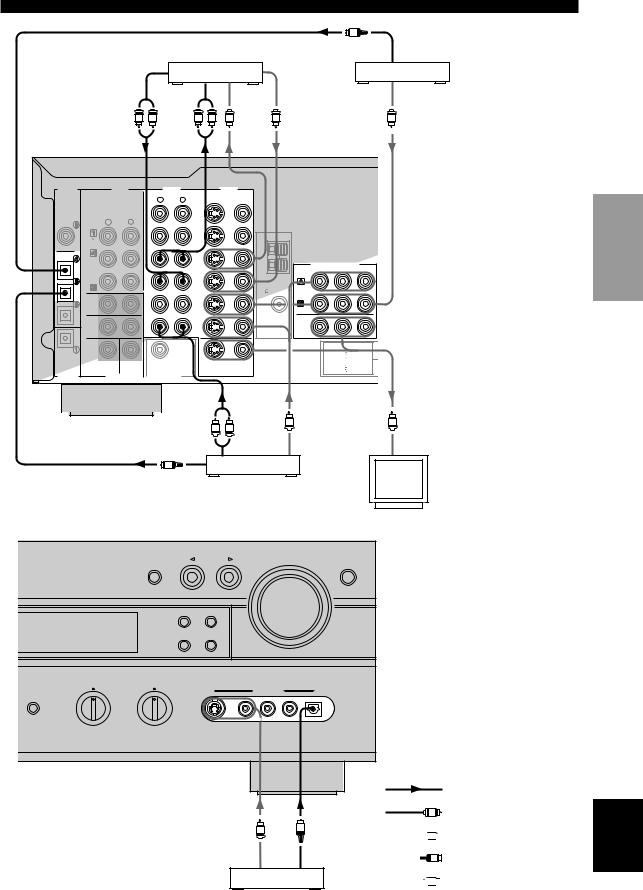
CONNECTIONS
|
|
|
O |
TV/digital TV/ |
|
|
|
OPTICAL |
|
|
VCR 1 |
|
OUTPUT |
cable TV |
AUDIO |
AUDIO |
VIDEO |
VIDEO |
VIDEO |
OUTPUT |
INPUT |
INPUT |
OUTPUT |
OUTPUT |
L |
R |
L |
R |
V |
V |
V |
DIGITAL |
AUDIO |
|
INPUT |
|
|
CD |
R |
L |
|
|
|
|
CD |
|
COAXIAL |
|
|
OPTICAL |
|
|
D-TV/CBL |
OUT |
|
|
(REC) |
|
|
MD |
|
|
/CD-R |
|
|
IN |
|
DVD |
(PLAY) |
|
MD/CD-R |
MAIN |
|
|
SURROUND |
|
MD/CD-R |
|
|
OPTICAL |
|
|
|
SUB |
|
|
WOOFER CENTER |
|
DIGITAL |
|
|
OUTPUT |
6CH INPUT |
|
(RX-V630RDS) |
|
|
|
AUDIO |
VIDEO |
|
R |
L |
S VIDEO |
VIDEO |
OUT |
|
|
VCR 2 |
|
|
/VDR |
|
|
IN |
TUNER |
|
|
AM |
|
|
ANT |
|
OUT |
|
|
|
GND |
|
VCR 1 |
|
|
IN |
|
|
|
75 |
UNBAL. |
D-TV |
FM |
|
/CBL |
ANT |
|
DVD |
|
|
SUB
WOOFER
S VIDEO |
VIDEO |
MONITOR OUT

 OUTPUT
OUTPUT
COMPONENT VIDEO |
|
||
PR/CR |
PB/CB |
Y |
|
DVD |
|
|
|
D-TV |
|
|
|
/CBL |
|
|
|
MONITOR |
|
|
|
OUT |
|
|
|
|
MAIN |
|
|
|
A OR B:4 MIN. /SPEAKER |
||
|
A+B :8 |
MIN. /SPEAKER |
|
|
CENTER :6 |
MIN. /SPEAKER |
|
|
REAR CENTER |
MIN. /SPEAKER |
|
|
:6 |
||
|
REAR :6 |
MIN. /SPEAKER |
|
L |
R |
V |
V |
|
|
||
|
AUDIO |
VIDEO |
VIDEO |
|
OUTPUT |
OUTPUT |
INPUT |
O |
|
OPTICAL |
DVD player |
OUTPUT |
Video monitor
|
|
|
|
INPUT |
|
VOLUME |
|
|
|
INPUT M0DE |
|
|
|
6CH INPUT |
|
|
|
|
PRESET/TUNING |
FM/AM |
|
|
|
|
|
|
EDIT |
|
|
|
|
|
|
|
TUNING MODE |
MEMORY |
|
|
|
|
|
|
AUTO/MAN'L MONO |
MAN'L/AUTO FM |
|
|
|
|
BASS |
TREBLE |
|
|
|
|
|
|
|
|
|
|
|
VIDEO AUX |
|
A/B/C/D/E |
|
|
|
|
|
|
|
– |
+ |
– |
+ |
S VIDEO |
VIDEO |
L AUDIO R |
OPTICAL |
PREPARATION
(RX-V630RDS)
|
V |
O |
VIDEO |
|
OPTICAL |
OUTPUT |
|
OUTPUT |
Game console or camcorder
indicates signal direction
L |
indicates left analog cables |
|



 R
R 

 indicates right analog cables
indicates right analog cables
 O
O  indicates optical cables
indicates optical cables


 V
V 


 indicates video cables
indicates video cables
English
15
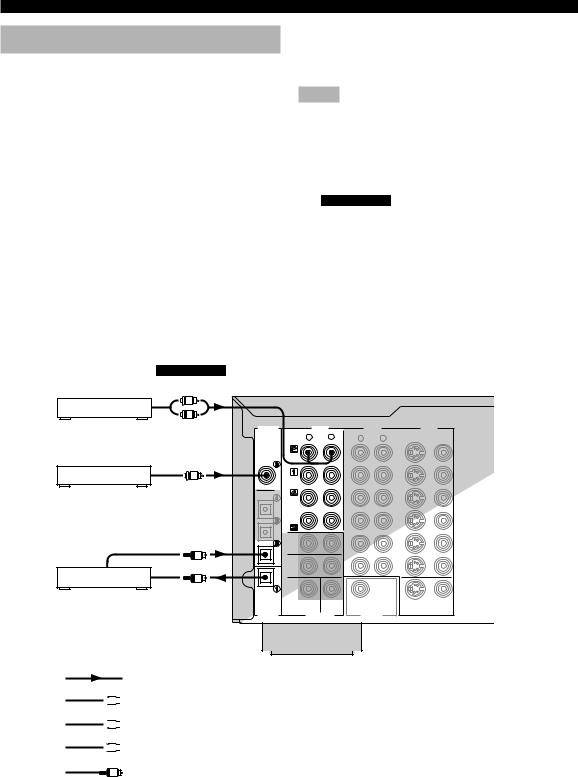
CONNECTIONS
Connecting audio components
■ Connecting a CD player
Connect the coaxial digital output jack on your CD player to the DIGITAL INPUT CD jack.
y
•The AUDIO jacks are available for a CD player which does not have coaxial digital output jack.
■Connecting a CD recorder or MD recorder
Connect the optical digital signal input jack on your CD recorder or MD recorder to the DIGITAL OUTPUT MD/ CD-R jack for digital recording.
Connect the optical digital output jack on your CD recorder or MD recorder to the DIGITAL INPUT MD/ CD-R jack to play a source from your recording component.
y
•The AUDIO jacks are available for an CD recorder or MD recorder which does not have optical digital input or output jack.
Notes
•Once you have connected a recording component to this unit, keep its power turned on while using this unit. If the power is off, this unit may distort the sound from other components.
•DIGITAL OUTPUT jack and analog OUT (REC) jacks are independent. Only digital signals are output from DIGITAL OUTPUT jack and analog signals from OUT (REC) jacks.
■DSP-AX630SE Connecting a tuner
Connect the output jacks on your tuner to the TUNER jacks.
DSP-AX630SE
AUDIO
OUTPUT
L |
R |
Tuner |
DIGITAL |
AUDIO |
|
|
AUDIO |
VIDEO |
|
|
INPUT |
R |
L |
|
|
|
|
|
|
R |
L |
S VIDEO |
VIDEO |
||
COAXIAL |
|
TUNER |
|
|
|
OUT |
|
|
|
|
|
|
|
||
OUTPUT |
CD |
|
|
|
|
VCR 2 |
|
|
|
|
|
/VDR |
|
||
|
|
|
|
|
|
||
C |
|
CD |
|
|
|
IN |
|
|
|
|
|
|
|
|
|
CD player |
COAXIAL |
OUT |
|
|
|
OUT |
|
D-TV/CBL |
|
|
|
|
|||
|
OPTICAL |
|
|
|
|
|
|
|
|
(REC) |
|
|
|
|
|
|
|
MD |
|
|
|
VCR 1 |
|
|
|
/CD-R |
|
|
|
|
|
|
|
|
|
|
|
|
|
|
DVD |
IN |
|
|
|
IN |
|
|
(PLAY) |
|
|
|
|
||
OPTICAL |
MD/CD-R |
MAIN |
|
|
|
D-TV |
|
OUTPUT |
|
|
|
/CBL |
|
||
|
|
|
|
|
|
||
O |
|
|
|
|
|
|
|
|
|
SURROUND |
|
|
|
DVD |
|
O |
|
|
|
|
|
|
|
OPTICAL |
MD/CD-R |
|
|
|
WOOFER |
|
|
|
|
|
|
|
SUB |
|
|
CD recorder or INPUT |
OPTICAL |
|
|
|
|
|
|
|
SUB |
|
|
|
S VIDEO |
VIDEO |
|
MD recorder |
|
WOOFER CENTER |
|
|
MONITOR OUT |
||
DIGITAL |
|
|
|
|
|||
|
OUTPUT |
6CH INPUT |
OUTPUT |
|
|
||
(DSP-AX630SE)



 L
L 






 R
R 






 C
C 



O
indicates signal direction indicates left analog cables indicates right analog cables indicates coaxial cables indicates optical cables
16
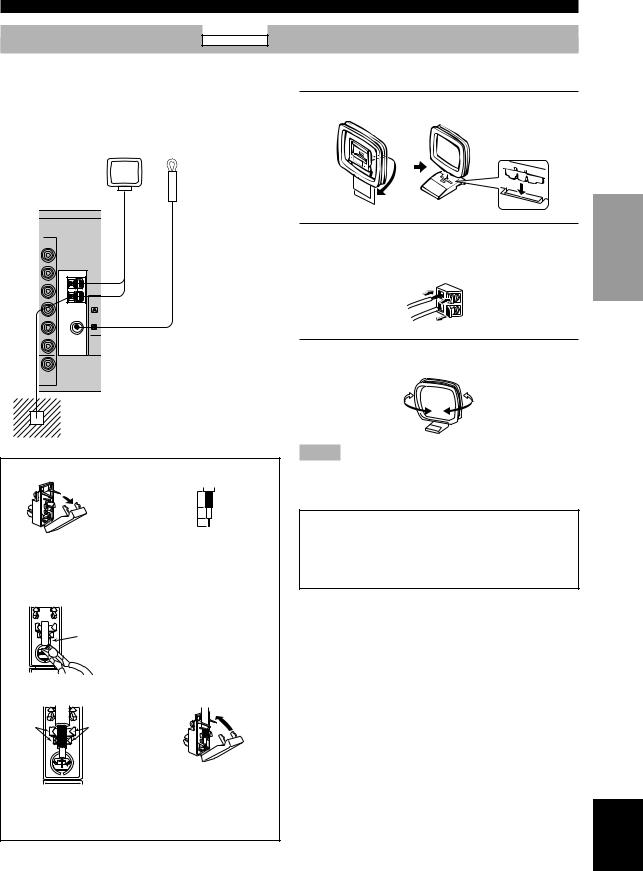
CONNECTIONS
Connecting the antennas RX-V630RDS
Both AM and FM indoor antennas are included with this unit. In general, these antennas should provide sufficient signal strength.
Connect each antenna correctly to the designated terminals.
AM loop antenna
(included) Indoor FM antenna
(included)
O
VIDEO
TUNER |
|
|
AM |
|
|
ANT |
|
|
GND |
|
|
|
|
DVD |
75 |
UNBAL. |
D-TV |
FM |
|
/CBL |
|
|
|
ANT |
|
|
|
|
MONIT |
|
|
OUT |
VIDEO
R OUT
Ground (GND terminal)
For maximum safety and minimum interference, connect the antenna GND terminal to a good earth ground. A good earth ground is a metal stake driven into moist earth.
■ Connecting the AM loop antenna
1 Set up the AM loop antenna, then connect it.
2 Press and hold the tab to insert the AM loop antenna lead wires into the AM ANT and GND terminals.
3 Orient the AM loop antenna for the best reception.
PREPARATION
75-ohm/300-ohm antenna adapter (U.K. model)
1 |
2 |
|
|
|
11 |
(7/16) |
|
|
8 |
(5/16) |
Unit: |
|
6 |
(1/14) |
mm (inch) |
Open the cover of the |
Cut the external sleeve |
||
included 75-ohm/300-ohm |
of the 75-ohm coaxial |
||
antenna adapter. |
cable and prepare it for |
||
|
connection. |
|
|
3
Lead wire
Cut the lead wire and remove it.
4
Clamp |
Clamp with |
with |
pliers. |
pliers.
 Insert the wire into the slot.
Insert the wire into the slot.
Insert the cable wire into the slot, and clamp it with pliers.
5
Snap the cover into place.
Notes
•The AM loop antenna should be placed away from this unit.
•The AM loop antenna should always be connected, even if an outdoor AM antenna is connected to this unit.
A properly installed outdoor antenna provides clearer reception than an indoor one. If you experience poor reception quality, an outdoor antenna may improve the quality. Consult the nearest authorized YAMAHA dealer or service center about the outdoor antennas.
English
17
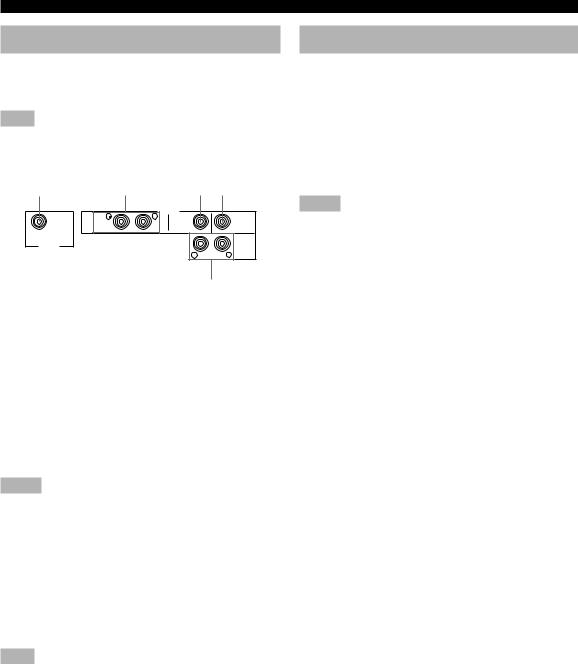
CONNECTIONS
Connecting an external amplifier
If you want to increase the power output to the speakers, or want to use another amplifier, connect an external amplifier to the OUTPUT jacks as follows.
Note
•When RCA pin plugs are connected to the OUTPUT jacks for output to an external amplifier, signals are output from the SPEAKERS terminals as well.
1 |
2 |
3 4 |
||
|
|
OUTPUT |
|
|
SUB |
R |
L |
|
|
MAIN |
REAR |
|
CENTER |
|
WOOFER |
CENTER |
|
||
|
|
|
||
OUTPUT |
|
|
|
|
|
|
R |
REAR |
L |
|
|
(SURROUND) |
||
|
|
|
|
|
5
1 SUBWOOFER jack
When using a subwoofer with built-in amplifier, including the YAMAHA Active Servo Processing Subwoofer System, connect the input jack of the subwoofer system to this jack. Low bass signals distributed from the main, center and/or rear channels are directed to this jack in accordance with your SPEAKER SET selections. The LFE (low-frequency effect) signals generated when Dolby Digital or DTS is decoded are also directed to this jack in accordance with your SPEAKER SET selections.
Notes
•The cut-off frequency of the SUBWOOFER jack is 90 Hz.
•If you do not use a subwoofer, designate the signals to the main left and right speakers by changing the settings of SPEAKER SET item “1E BASS” on the SET MENU.
•Use the control on the subwoofer to adjust its volume level. It is also possible to adjust the volume level by using this unit’s remote control (see “ADJUSTING THE LEVEL OF THE EFFECT SPEAKERS” on page 51).
2 MAIN jacks
Main channel line output jacks.
Note
•The signals output through these jacks are affected by the BASS and TREBLE settings.
3 REAR CENTER jack
Rear center channel line output jack.
4 CENTER jack
Center channel line output jack.
5 REAR (SURROUND) jacks
Rear channel line output jacks.
Connecting an external decoder
This unit is equipped with 6 additional input jacks (MAIN left and right, CENTER, SURROUND left and right, and SUBWOOFER) for discrete multi-channel input from an external decoder, sound processor, or pre-amplifier.
Connect the output jacks on your external decoder to the 6CH INPUT jacks. Be sure to match the left and right outputs to the left and right input jacks for the main and surround channels.
Notes
•When you select 6CH INPUT as the input source, this unit automatically turns off the digital sound field processor, and you cannot listen to DSP programs.
•When you select 6CH INPUT as the input source, settings of “1 SPEAKER SET” on the SET MENU do not apply (except for “1F MAIN Lv”).
18
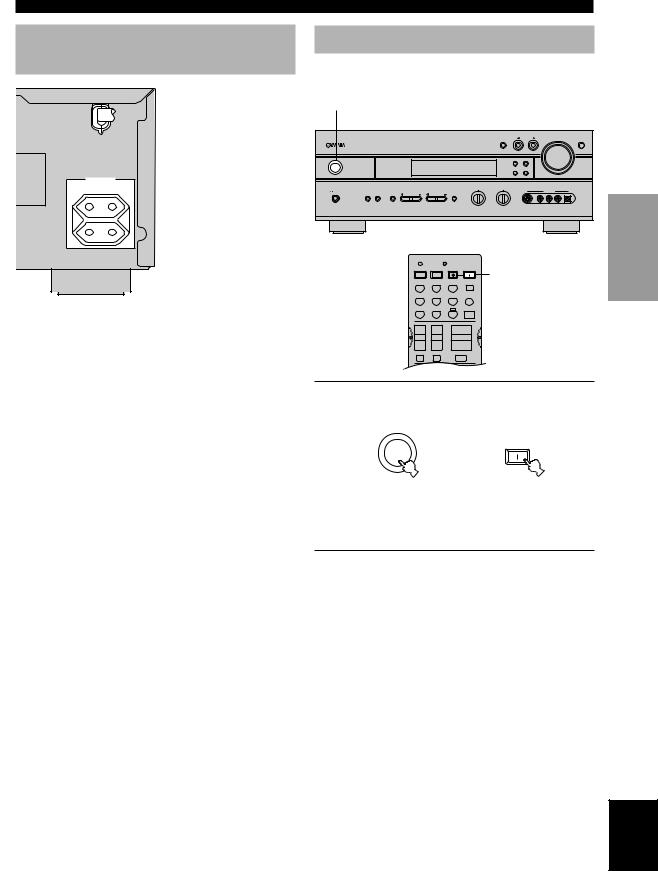
Connecting the power supply
cords
AC OUTLETS |
SWITCHED |
100W MAX. TOTAL |
(Europe model)
■ Connecting the AC power cord
Plug in this unit to the wall outlet.
■ AC OUTLETS (SWITCHED)
U.S.A., Canada, China, Europe, Singapore and
General models .............................................. |
2 OUTLETS |
U.K. and Australia model ................................ |
1 OUTLET |
Use these outlets to connect the power cords from your components to this unit. The power to the AC OUTLETS is controlled by this unit’s STANDBY/ON (or SYSTEM POWER and STANDBY). These outlets will supply power to any source component connected to this unit whenever this unit is turned on. The maximum power (total power consumption of components) that can be connected to the AC OUTLETS varies depending on the
area which it was purchasing. |
|
China and General models ......................................... |
50 W |
Other models ........................................................... |
100 W |
CONNECTIONS
Turning on the power
When all connections are complete, turn on the power of this unit.
1
|
|
|
|
|
|
|
|
|
|
INPUT |
VOLUME |
|
|
|
|
|
|
|
|
INPUT M0DE |
|
6CH INPUT |
|
|
NATURAL SOUND AV RECEIVER |
|
|
|
|
|
|
|
|
|
|
|
|
|
|
|
|
|
|
|
PRESET/TUNING |
FM/AM |
|
STANDBY |
|
|
|
|
|
|
|
|
|
|
|
/ON |
|
|
|
|
|
|
|
|
TUNING MODE |
MEMORY |
|
|
|
|
|
|
|
|
|
|
|
||
|
|
|
|
|
|
|
|
|
AUTO/MAN'L MONO |
MAN'L/AUTO FM |
|
|
|
|
|
|
|
|
BASS |
|
TREBLE |
|
|
SILENT |
SPEAKERS |
|
|
|
|
|
|
|
|
VIDEO AUX |
|
|
A |
B |
STEREO |
PROGRAM |
PRESET/TUNING |
A/B/C/D/E |
|
|
|
|
|
|
|
|
|
|
|
– |
+ |
– |
+ |
|
|
CODE SET |
TRANSMIT |
|
|
|
POWER |
POWER |
STANDBY |
SYSTEM |
1 |
POWER |
||||
TV |
AV |
|
|
|
CD |
MD/CD-R |
TUNER |
SLEEP |
|
DVD |
D-TV/CBL |
V-AUX |
6CH INPUT |
|
VCR 1 |
VCR1/DVR |
A |
AMP |
|
+ |
+ |
|
+ |
|
TV VOL |
TV CH |
VOLUME |
|
|
– |
– |
|
– |
|
TV MUTE |
TV INPUT |
|
|
|
|
|
MUTE |
|
|
HALL |
JAZZ CLUB |
ROCK |
ENTER- |
|
CONCERT |
TAINMENT |
|
||
1 Press STANDBY/ON (SYSTEM POWER on the remote control) to turn on the power of this unit.
|
SYSTEM |
|
POWER |
STANDBY |
or |
/ON |
|
Front panel |
Remote control |
The level of the main volume, and then the current DSP program name appear on the front panel display.
2 Turn on the video monitor connected to this unit.
PREPARATION
English
19
